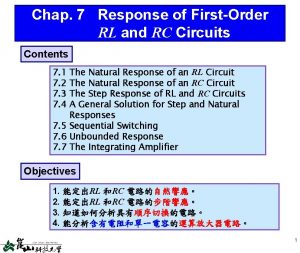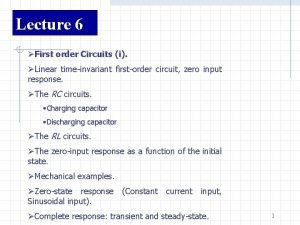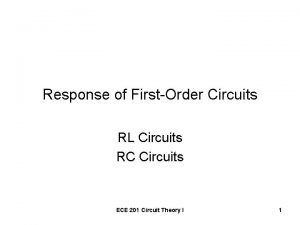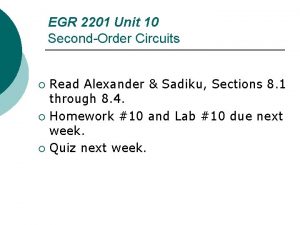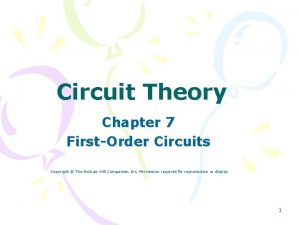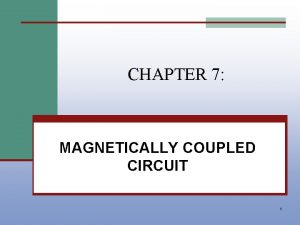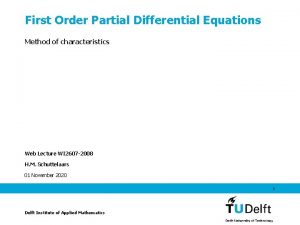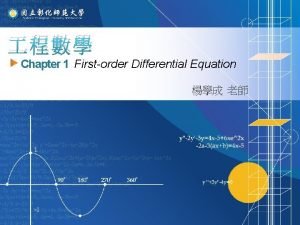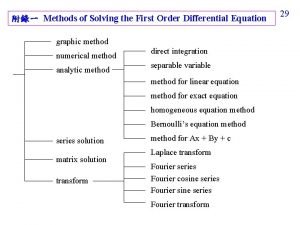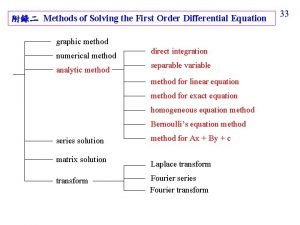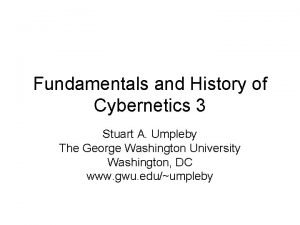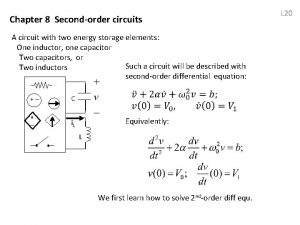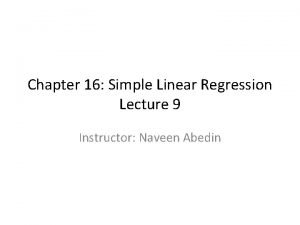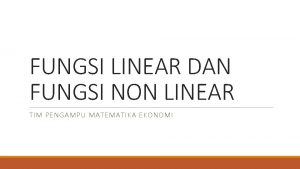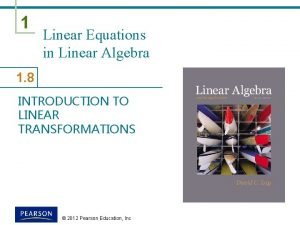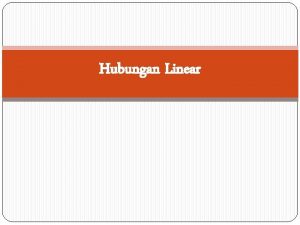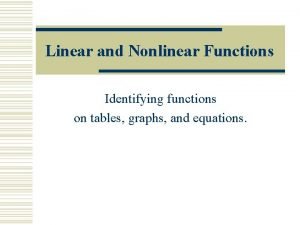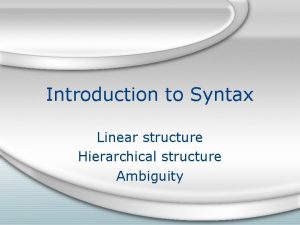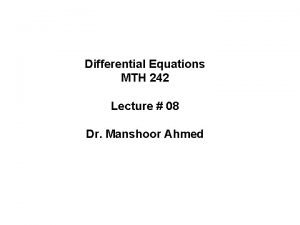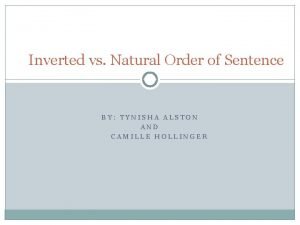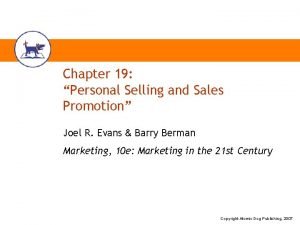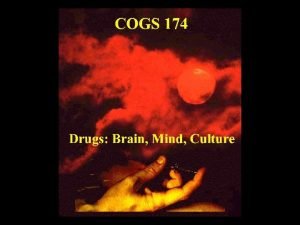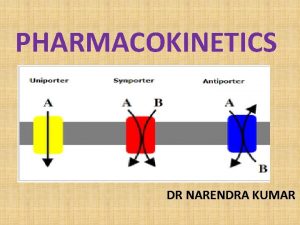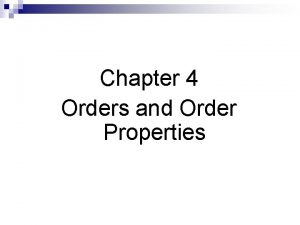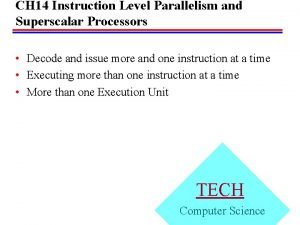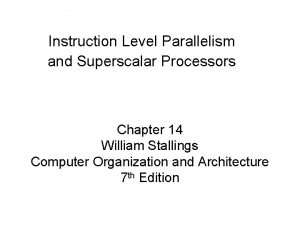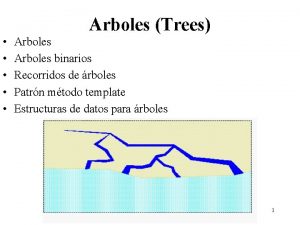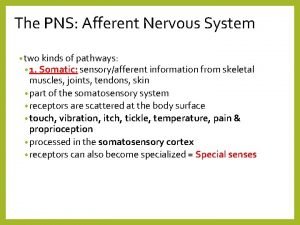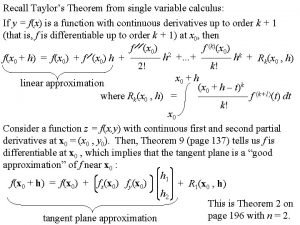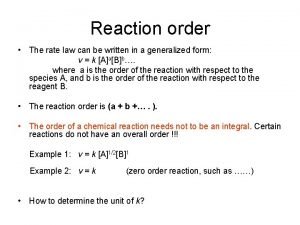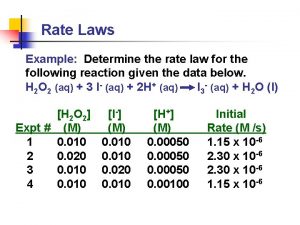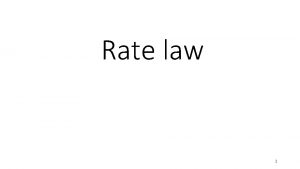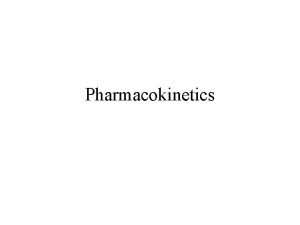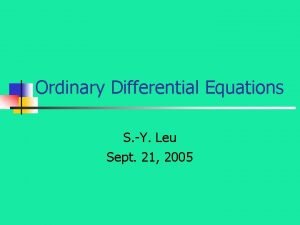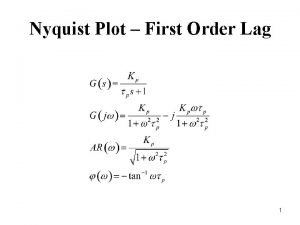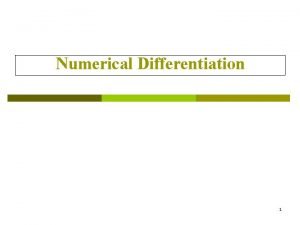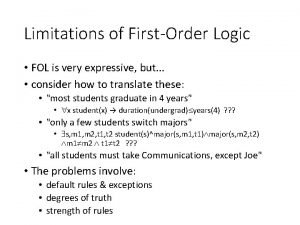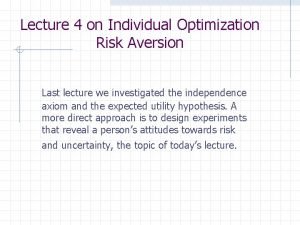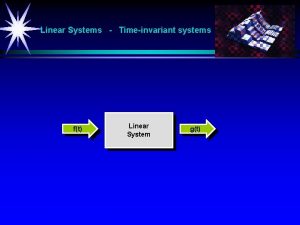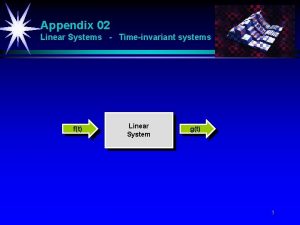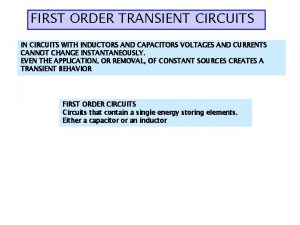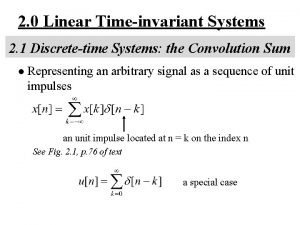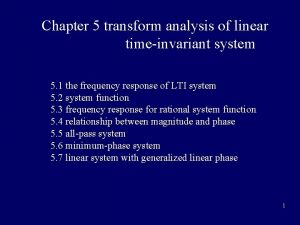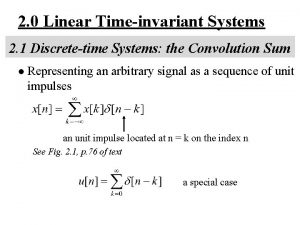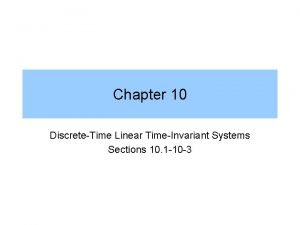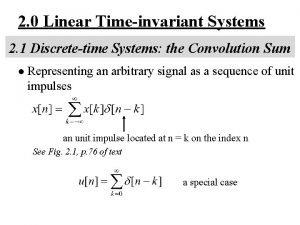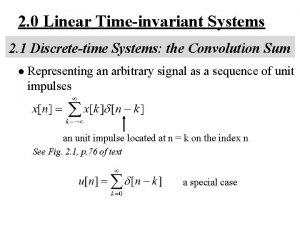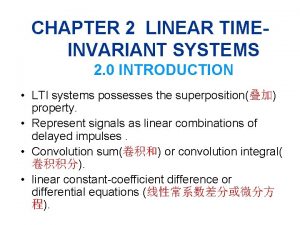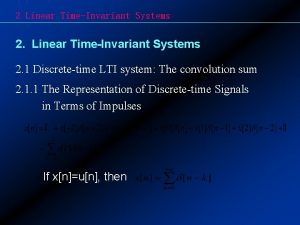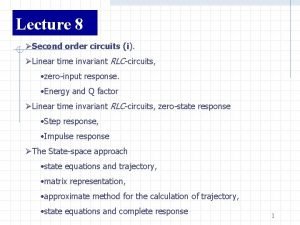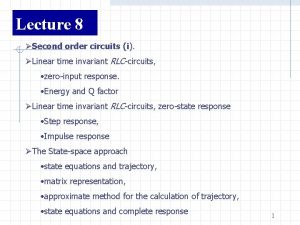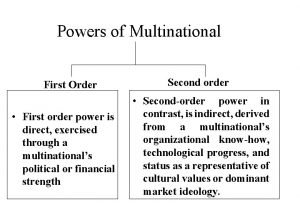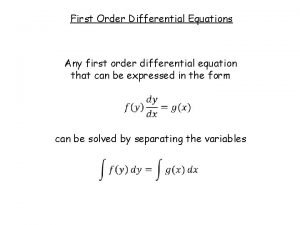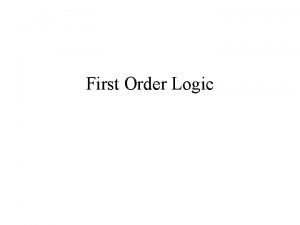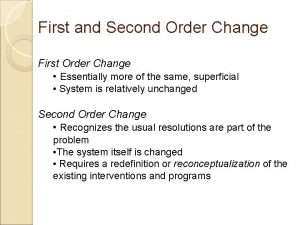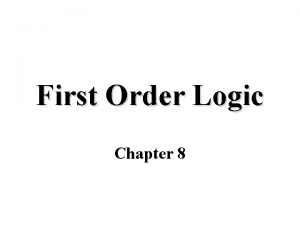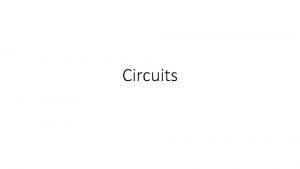Lecture 6 First order Circuits i Linear timeinvariant


































































- Slides: 66

Lecture 6 ØFirst order Circuits (i). ØLinear time-invariant first-order circuit, zero input response. ØThe RC circuits. • Charging capacitor • Discharging capacitor ØThe RL circuits. ØThe zero-input response as a function of the initial state. ØMechanical examples. ØZero-state response (Constant current input, Sinusoidal input). ØComplete response: transient and steady-state. 1

Why first order? In this lecture we shall analyze circuits with more than one kind of element; as a consequence, we shall have to use differentiation and/or integration. We shall restrict ourselves here to circuits that can be described by first-order differential equations; hence we give them the name first- order circuits 2

Linear Time –invariant First order Circuit. Zero-input Response The RC Circuits In the circuit of Fig. 6. 1. , the linear time-invariant capacitor with capacitance C is charged to a potential V 0 by a constant voltage source. At t=0 the switch k 1 is opened, and switch k 2 is closed simultaneously. k 2 k 1 E=V 0 v=V 0 i(t) + _ C R Fig. 6. 1 A charged capacitor is connected to a resistor ( k 1, opens and k 2 closes at t=0). 3

Thus the charged capacitor is disconnected from the source and connected to the linear time-invariant resistor with resistance R at t=0 Let us describe physically what is going to happen. Because of the charges stored in the capacitor (Q 0=CV 0) a current will flow in the direction specified by the reference direction assigned to i(t), as shown in Fig. 6. 1. The charge across the capacitor will decrease gradually and eventually will become zero; the current i will do the same. During the process the electric energy stored in the capacitor is dissipated as heat in the resistor. Let us restricting our attention to t 0, ic(t) i. R(t) we redraw the RC circuit as shown in + + Fig. 6. 2. Note that the reference + v (t ) vc(t)=V 0 v. C(t) R direction for branch voltages and branch currents are clearly indicated. V 0 along with the positive and negative sins next to the capacitor, specifies the magnetite and polarity of Fig. 6. 2 An RC circuit, vc(0)=V 0 the initial voltage. 4

Kirchoff`’s laws and topology dictate the following equations: KVL: (6. 1) KCL: (6. 2) The two branch equations for the two circuit elements are Resistor: (6. 3) Capacitor: (6. 4 a) or, equivalently (6. 4 b) In Eq. (6. 4 a) we want to emphasize that the initial condition 5

Of the capacitor voltage must be written together with ; otherwise, the state of the capacitor is not completely specified. This is made obvious by the alternate branch equation (6. 4 b) Finally we have four equations for four unknown in the circuit, namely, the two branch voltages v. C and v. R and two branch currents i. C and i. R. A complete mathematical description of the circuit has been given and we can solve for any or all of the unknown parameters. If we wish to find the voltage across the capacitor, the combining Eqs (6. 1) to (6. 4 a) we obtain for t 0, (6. 5) 6

This is a first-order linear homogeneous differential equation with constant coefficients. Its solution is of the exponential form (6. 6) where (6. 7) This easily verified by direct substitution of Eqs. (6. 6) and (6. 7) in the differential equation (6. 5). In (6. 6) K is a constant to be determined from the initial conditions. Setting t=0 in Eq. (6. 6), we obtain v. C(0)=K=V 0. Therefore, the solution to the problem is given by (6. 8) 7

In Eq. (6. 8), v. C(t) is specified for t 0 since for negative t the voltage across the capacitor is a constant, according to our original physical specification. The voltage v. C(t) is plotted in Fig. 6. 3 as a function of time. Of course, we can immediately the other three branch variables once v. C(t) is known. From Eq. (6. 4 a) we have v. C V 0 (6. 9) From Eq. (6. 2) we have (6. 10) From Eq. (6. 3) we have 0. 377 V 0 (6. 11) 0 T 2 T 3 T 4 T t Fig. 6. 3 The discharge of the Capacitor of Fig. 6. 2 is given by an experimental curve 8

i. C Exercise t 0 Show that the red line in Fig. 6. 3, which is tangent to the curve vc(t)=0+, intersects the time axis at the abscissa T i. R v. R t Fig. 6. 4. Network variables i. C , i. R and v. R against time for t 0. t 9

Let us study the waveform vc( ) more carefully. The voltage across the capacitor decreases exponentially with time, as shown in Fig. 6. 3. An exponential curve can be characterized by two numbers, namely the ordinate of the curve at a reference time say t=0 and the time constant T which is defined by. In Fig. 6. 3 we have f=V 0 and T=RC. Remark The term s 0=-1/T=-1/RC in Eqs. (6. 6) and (6. 7 has a dimension of reciprocal time of frequency and is measured in radians per second. It is called the natural frequency of the circuit. Exercise Recall that the unit of capacitance is the farad and the unit of resistance is the ohm. Show that the unit of T=RC is the second. In the circuit analysis we are almost always interested in the behavior of a particular network called the response. In general we give the name of zero-input response to the response of the circuit with no 10 applied input

The RL (Resistor –Inductor) Circuit The other typical first-order circuit is the RL circuit. We shall study its zero-input response. As shown in Fig. 6. 5 for t<0, switch k 1 is on terminal B, k 2 is open, and the linear time-invariant inductor with inductance L is supplied with a constant current I 0. At t=0 switch k 1 is flipped to terminal C and k 2 is closed. Thus for t 0 the inductor with initial current I 0 is connected to a linear time-invariant resistor with resistance R. The energy stored in the magnetic field as a result of I 0 in the inductance decreases gradually and dissipate in the resistor in the form of heat. The current in the RL loop decreases monotonically and eventually tends to zero. A k 1 I 0 B k 2 L Fig. 6. 5. for t<0, switch k 1 is on terminal B, k 2 is open; therefore for t<0, the current I 0 goes through the inductor L R 11

In the same way as in RC case we redraw the RL circuit for t 0 as shown in Fig. 6. 6. Note that the reference direction of all branch voltages and branch currents are clearly indicated. KCL says i. R=-i. L and KVL states v. L-v. R=0. Using the branch equations for both elements that , we obtain the is , following differential equation in terms of the current i. L: (6. 12) This is a first-order linear homogeneous differential equation with constant coefficients; it has precisely the same form as the previous Eq. 6. 5. Therefore the solution is the same except notations + v. L(t) - (6. 13) + v. R i. L(0)=I 0 - i. R where L/R=T is the time constant and s 0=-R/L is the natural frequency Fig. 6. 6 An RL circuit with i. L(0)=I 0 and the waveforms for t 0 12

The zero-input response as a function of the initial state For the RC circuit and the RL circuit considered above, the zero-input responses are respectively (6. 14) The initial conditions are specified by V 0 and I 0, respectively. The numbers V 0 and I 0 are also called the initial state of the RC circuit and of the RL circuit, respectively. The following conclusion could be reached if we consider the way in which the waveform of the zeroinput response depends on the initial state. For first-order linear time invariant circuits, the zero-input response considered as a waveform defined for 0 t < is a linear function of the initial state Let us prove this statement by considering the RC circuit. We wish to show that the waveform v( ) in Eq. (6. 14) is a linear function of the initial state V 0. It is necessary to check the requirements of homogeneity and addittivity for the function. 13

Homogeneity is obvious; if the initial state is multiplied by a constant k, (Eq. (6. 14)show that the whole waveform is multiplied by k. Adittivity as just as simple. The zero input response corresponding to the initial state V 0’ is and the zero-input response corresponding to some other initial state V 0” is Then the zero-input response corresponding to the initial state This waveform is the sum of the two preceding waveforms. Hence addittivity holds. 14

Remark This property does not hold in the case of nonlinear circuits. Consider the RC circuit shown in Fig. 6. 7 a. The capacitor is linear and time invariant and has a capacitance of 1 farad, and the resistor is nonlinear with characteristic The two elements have the same voltage v, and expressing the branch currents in terms of v, we obtain from KCL + v - i. R C=1 F + v. R Hence - Fig. 6. 7 a Nonlinear RC circuit and two of its zero-input resistance. The capacitor is linear and the resistor If we integrate between 0 an t, the voltage takes the initial value V 0 and the final value v(t); hence 15

or (6. 15) This is the zero-input response of this nonlinear RC circuit starting from the initial state V 0 at time 0. The waveforms corresponding to V 0=0. 5 and V 0=2 are plotted in Fig 6. 7 b. v It is obvious that the top curve (V 0=2) =2 cannot be obtained from the lower one (for V 0=0. 5) =0. 5 by multiplying its ordinates by 4. 2. 0 1. 5 1. 0 V 0=2 0. 5 V 0=0. 5 t Fig. 6. 7 b 16

Mechanical example Let us consider a familiar mechanical system that has a behavior similar to that of the linear time invariant RC and RL circuits above. Figure 6. 8 shows a block of mass M moving at an initial velocity V 0 at t=0 M v(t) v(0)=V 0 Bv (friction forces) Fig. 6. 8 A mechanical system which is described by a first order differential equation As time proceeds, the block will slow down gradually because friction tends to oppose the motion. Friction is represented by friction forces that are all ways in the direction opposite to the velocity v, as shown in the figure. Let us assume that these forces are proportional to the magnitude of the velocity; thus, f=Bv, Bv where the constant B is called the damping coefficient. From Newton’s second law of motion we have, for t 0, 17

(6. 16) Therefore (6. 17) where M/B represents the time constant for the mechanical system and –B/M is the natural frequency 18

Zero-state Response Constant Current Input In the circuit of Fig. 6. 9 a current source is is switched to a parallel linear time invariant RC circuit. For simplicity we consider first the case when the current is is constant and equal to I. Prior to the opening of the switch the current source produces a circulating current in the short circuit. At t =0, the switch is opened and thus the current source is connected the RC circuit. From KVL we see that the voltage across all three elements is the same. Let us design this voltage by v and assume that v is the response of interest. Writing the KCL equation in terms of v, we obtain the following network equation: is(t)=I k C R Fig. 6. 9 RC circuit with current source input. At t=0, switch k is opned 19

(6. 18) where I is a constant. Let us assume that the capacitor is initially uncharged. Thus, the initial condition is (6. 19) Before we solve Eqs. (6. 18) and (6. 19), let s figure out what will happen after we open the switch. At t=0+, that is, immediately after the opening of the switch, the voltage across the capacitor remains zero, because as we learned the voltage across a capacitor cannot jump abruptly unless there is an infinitely large current. At t=0+, since the voltage is still zero, the current in the resistor must be zero by Ohm’s law. Therefore all the current from the source enters the capacitor at t=0+. Thus implies a rate of increase of the voltage specified by Eq. (6. 19), thus (6. 20) 20

As time proceeds, v increases, and v/R, v/R the current through the resistor, increases also. Long after the switch is opened the capacitor is completely charged, and the voltage is practically constant. Then and thereafter, dv/dt 0. All the current from the source goes through the resistor, and the capacitor behaves as an open circuit, that is (6. 21) This fact is clear form Eq. (6. 18), and it is also shown in Fig. 6. 10. The circuit is said to have reached a steady state. It only remains to show the whole change of voltage takes place. For that we rely on the following analytical treatment. The solution of a linear no homogeneous differential equation can be written in the following form: v (6. 22) RI t Fig. 6. 10. Initial and final behavior of the voltage across the capacitor. 21

where vh is a solution of the homogeneous differential equation and vp is any particular solution of the nonhomogenous differential equation. vp depends on the input. The general solution of the homogeneous equation is of the form (6. 23) where K 1 is any constant. The most convenient particular solution for a constant current input is a constant (6. 24) since the constant RI satisfies the differential equation (6. 18). Substituting (6. 23) and (6. 24) in (6. 22), we obtain the general solution of (6. 18) (6. 25) where K 1 is to be evaluated from the initial condition specified by Eq. (6. 19). Setting t=0 in (6. 25), we have 22

Thus, (6. 26) The voltage as a function of time is then (6. 27) 0. 05 RI v 0. 02 RI RI 0. 63 RI T 2 T 3 T 4 T The graph in Fig. 6. 11 shows the voltage approaching its steady-state value exponentially. At about four times the time constant, the voltage is with two percent of its final value RI t Fig. 6. 11. Voltage response for the RC circuit due to a constant source I as shown in Fig. 6. 10 where v=0 23

Exercise 1 Sketch with appropriate scales the zero state response of the of Fig. 6. 10 with a. I=200 m. A, R=1 k , and C=1 F b. I=2 m. A, R=50 , and C=5 n. F Exercise 2 a. Calculate and sketch the waveforms ps( ) (the power delivered by the source), p. R( ) (the power dissipated by the resistor) and EC( ), (the energy stored in the capacitor) b. Calculate the efficiency of the process, i. e the ratio of the energy eventually stored in the capacitor to the energy delivered by the source [ ] 24

Sinusoidal Input We consider now the same circuit but with a different input; the source is now given by a sinusoid (6. 28) where the constant A 1 is called the amplitude of the sinusoids and the constant is called the (angular) frequency. The frequency is measure in radians per second. The constant 1 is called phase. The solution of the homogeneous differential equation if of the same form (See Eq. (6. 23)), since the circuit is the same except input. The most convenient particular solution of a linear differential equation with a constant coefficient for a sinusoidal input is a sinusoid of the same frequency. Thus vp is taken to be of the form (6. 29) where A 2 and 2 are constants to be determined. To evaluate them , we substitute (6. 29) in the given differential equation, namely 25

(6. 30) We obtain (6. 31) Using standard trigonometric identities to express and as a linear combination of equating separately the coefficients of the following results: and , and we obtain (6. 32) and (6. 33) 26

Here tan-1 RC denotes the angle between 0 and 90 o whose tangent is equal to RC. This particular solution and the input current are plotted in Fig. 6. 12. is A 1 t A 2 vp Fig. 6. 12 Input current and a particular solution for the output voltage of the RC circuit in Fig. 6. 9. t 1 t 27

Exercise Derive Eqs. (6. 32) and (6. 33) in detail. The general solution of (6. 31) is therefore of the form (6. 34) Setting t=0, t=0 we have (6. 35) that is (6. 36) Therefore the response is given by (6. 37) where A 2 and 2 are defined in Eqs. (6. 32) and (6. 33). The graph of v, that is the zero-state response to the input A 1 cos( t+ 1), is plotted in Fig. 6. 13. 28

In the two cases treated in this lecture we considered the voltage v as the response and the current source is as the input. The initial condition in the circuit is zero; that is, the voltage across the capacitor is zero before the application of the input. In general we say that a circuit is in the zero state is all the initial conditions in the circuit are zero. The response of a circuit which starts from the zero state, is due exclusively to the input. By definition, the zero-state response is the response of a circuit to an input applied at some arbitrary time, say, t 0, subject to the condition that the circuit be in the zero state just prior to the application of the input (that is, at time t 0 -). v vp v(t) vh t Fig. 6. 13. Voltage response of the circuit in Fig. 6. 13 with v(0)=0 and is(t)=A 1 cos( t+ 1) In calculating zero-state responses, our primary interest is the behavior of the response for t t 0. It means that the input and the zero-state response are taken to be identically zero at t<t 0. 29

Complete Response: Transient and Steady state Complete response. The response of the circuit to both an input and the initial conditions is called the complete response of the circuit. Thus the zero-input response and the zero-state response are special cases of the complete response. Let us demonstrate that for the simple linear RC circuit considered, the complete response is the sum of the zero-input response and the zero-state response. B A is(t) k + V 0 - C + v - R Consider the circuit in Fig. 6. 14 where the capacitor is initially charged; that isv(0)=V 0 0, and a current input is switched into the circuit at t=0. Fig. 6. 14 RC circuit with v(0)=V 0 is excited by a current source The switch k is flipped from A to B at t=0 is(t). 30

By definition, the complete response is the waveform v( ) caused by both the input and the initial is( ) state V 0. (6. 38) with (6. 39) Where V 0 is the initial voltage of the capacitor. Let vi be the zero-input response; by definition, it is the solution of with Let v 0 be the zero-state response; by definition, it is the solution of with 31

From these four equations we obtain, by addition and However these two equations show that the waveform vi( )+v 0( ) satisfies both the required differential equation (6. 38) and the initial condition (6. 39). Since the solution of a differential equation such as (6. 38), subject to initial conditions such as (6. 39), is unique, it follows that the complete response v is given by that is, the complete response v is the sum of the zero-input response vi and the zero-state response v 0. 32

Example If we assume that the input is a constant current source applied at t=0, t=0 that is, is=I, =I the complete response of the current can be written immediately since we have already calculated the zero-input response and the zero-state response. Thus, From Eq. (6. 8) we have And from Eq. (6. 27) we have Thus the complete response is (6. 40) Complete response Zero-input Response vi Zero-state Response v 0 The responses are shown in Fig. (6. 15) 33

Remark We shall prove later that for the linear time invariant parallel RC circuit the complete response can be explicitly written in the following form for any arbitrary input is: Complete response Zero-input Response Exercise By direct substitution show that the expression for the complete response given in the remark satisfies (6. 38) and (6. 39) v RI Zero-state Response v 0 vi t Fig. 6. 15 Zero-input, zero state and complete response of the simple RC circuit. The input is a constant current source I applied at t=0 34

Transient and steady state. In the previous example we can also partition the complete response in a different way. The complete response due to the initial state V 0 and the constant current input I in Eq. (6. 40) 9 s rewritten as follows (6. 41) Complete response Transient Steady state The first term is a decaying exponential as represented by the shaded area, i. e. , the difference of the waveform v( ) and the constant RI in Fig. 6. 15. For very large t, the first term is negligible, and the second term dominates. For this reason we call the first term the transient and the second term the steady state. In this example it is evident that transient is contributed by both the zero-input response and the zerostate response, whereas the steady sate is contributed only by the zero-state response. Physically, the transient is a result of two cases, namely, the initial conditions in the circuit and a sudden application of the input. 35

The steady state is a result of only the input and has a waveform closely related to that of the input. If the input, for example, is a constant, the steady state response is also a constant; if the input is a sinusoid of angular frequency , the steady state response is also a sinusoid of the same frequency. In the example of sinusoid inpput, , the response has a steady state the input is and a transient portion Exercise The circuit shown in Fig. 6. 16 contains 1 -farad linear capacitor and a linear resistor with a negative resistance. When the current source is applied, it is in the zero state at time t=0, t=0 so that for t 0, is=Imcos t. is 1 F + v - Calculate and sketch the response v. -1 Is there a sinusoidal steady state? Fig. 6. 16 Exercise on steady state. 36

Circuits with Two Time Constants Problems involving the calculation of transients occur frequently in circuits with switches. Let us illustrate such a problem with the circuit shown in Fig. 6. 17. Assume that the capacitor and resistors are linear and time invariant, and that the capacitor is initially uncharged. For t<0 switch k 1 is closed and switch k 2 is open. Switch k 1 is opened at t=0 and thus connects the constant current source to the parallel RC circuit. The capacitor is gradually charged with the time constant T 1=R 1 C 1. Suppose that t=T 1 , switch k 2 is closed. The problem is to determine the voltage waveform across the capacitor for t 0. k 2 I k 1 C + v - R 1 R 2 Fig. 6. 17 A simple transient problem. The switch k 1 is opened at t=0; t=0 the switch k 2 is closed at t=T 1=R 1 C 1. We can divide the problem into to parts, the interval [0, T 1] and the interval [T 1, ]. First we determine the voltage in [0, T 1] before switch k 2 closes. 37

Since v(0)=0 by assumption, the zero-state response can be found immediately. Thus, (6. 42) At t=T 1 (6. 43) Which represents the initial condition for the second part of our problem. For t>T 1 , since switch k 2 is closed we have a parallel combination of C, R 1 and R 2; the time constant is (6. 44) and the input is I. The complete response for this second part is, for t T 1. (6. 45) 38

v R 1 I Time constant T 1 Time constant T 2 0 T 1 t Fig. 6. 18 Waveform of voltage for the circuit in Fig. 6. 17. 39

RC Circuits I a R C e RC R C e 2 RC Ce q 0 I b b Ce I a I RC + + - - 2 RC q t 0 t 40

• Calculate Charging of Capacitor through a Resistor • Calculate Discharging of Capacitor through a Resistor 41

Last time--Behavior of Capacitors • Charging – Initially, the capacitor behaves like a wire. – After a long time, the capacitor behaves like an open switch. • Discharging – Initially, the capacitor behaves like a battery. – After a long time, the capacitor behaves like a wire. 42

The capacitor is initially uncharged, and the two switches are open. E 3) What is the voltage across the capacitor immediately after switch S 1 is closed? a) Vc = 0 b) Vc = E c) Vc = 1/2 E 4) Find the voltage across the capacitor after the switch has been closed for a very long time. a) Vc = 0 c) Vc = 1/2 E b) Vc = E 43

Initially: Q = 0 VC = 0 I = E/(2 R) After a long time: VC = E Q=EC I=0 44

Preflight 11: E 6) After being closed a long time, switch 1 is opened and switch 2 is closed. What is the current through the right resistor immediately after the switch 2 is closed? a) IR= 0 b) IR=E/(3 R) c) IR=E/(2 R) d) IR=E/R 45

After C is fully charged, S 1 is opened and S 2 is closed. Now, the battery and the resistor 2 R are disconnected from the circuit. So we now have a different circuit. Since C is fully charged, VC = E. Initially, C acts like a battery, and I = VC/R. 46

RC Circuits (Time-varying currents) I a • Charge capacitor: R C initially uncharged; connect switch to a at t=0 Calculate current and I b e C charge as function of time. Would it matter where R is placed in the loop? ? • Loop theorem • Convert to differential equation for Q: 47

RC Circuits (Time-varying currents) Charge capacitor: I a I R b C e • Guess solution: • Check that it is a solution: Note that this “guess” incorporates the boundary conditions: ! 48

RC Circuits (Time-varying currents) I a • Charge capacitor: I R b C e • Current is found from differentiation: Conclusion: • Capacitor reaches its final charge(Q=Ce ) exponentially with time constant t = RC. • Current decays from max (=e /R) with same time constant. 49

Charging Capacitor Charge on C Max = Ce 63% Max at t=RC RC Ce Q 0 Current Max = e /R 2 RC t e /R I 37% Max at t=RC 0 t 50

a • At t=0 the switch is thrown from position b to position a in the circuit shown: The capacitor is initially uncharged. – At time t=t 1=t, the charge Q 1 on the capacitor is I I R b e C (1 -1/e) of its asymptotic charge Qf=Ce. – What is the relation between Q 1 and Q 2 , the charge on the capacitor at time t=t 2=2 t ? (a) Q 2 < 2 Q 1 R (c) Q 2 > 2 Q 1 (b) Q 2 = 2 Q 1 • The point of this ACT is to test your understanding of the exact time dependence of the charging of the capacitor. • Charge increases according to: • So the question is: how does this charge increase differ from a linear increase? 2 Q 1 • From the graph at the right, it is clear that the charge increase is not as fast as linear. • In fact the rate of increase is just proportional to the current (d. Q/dt) which decreases with time. • Therefore, Q 2 < 2 Q 1. Q 2 Q 1 Q t 2 t 51

RC Circuits (Time-varying currents) • Discharge capacitor: C initially charged with Q=Ce Connect switch to b at t=0. Calculate current and charge as function of time. • I a b e I R C + + - - Loop theorem • Convert to differential equation for Q: 52

RC Circuits (Time-varying currents) Discharge capacitor: I a b e • Guess solution: I R C + + - - Q = Ce e -t/RC • Check that it is a solution: Note that this “guess” incorporates the boundary conditions: d. Q Q R dt + = - e e t / RC + e e t / RC = 0 C ! 53

RC Circuits (Time-varying currents) • Discharge capacitor: I a -t/RC Q = Cee b • Current is found from differentiation: Minus sign: original definition of current “I” direction I R C e + + - - Conclusion: • Capacitor discharges exponentially with time constant t = RC • Current decays from initial max value (= -e/R) with same time constant 54

Discharging Capacitor Ce Charge on C RC 2 RC Q = C e e -t/RC Max = Ce Q 37% Max at t=RC zero 0 t 0 Current I Max = -e/R 37% Max at t=RC -e /R t 55

Preflight 11: The two circuits shown below contain identical fully charged capacitors at t=0. Circuit 2 has twice as much resistance as circuit 1. 8) Compare the charge on the two capacitors a short time after t = 0 a) Q 1 > Q 2 b) Q 1 = Q 2 c) Q 1 < Q 2 56

Initially, the charges on the two capacitors are the same. But the two circuits have different time constants: t 1 = RC and t 2 = 2 RC. Since t 2 > t 1 it takes circuit 2 longer to discharge its capacitor. Therefore, at any given time, the charge on capacitor is bigger than that on capacitor 1. 57

• At t=0 the switch is connected to position a in the circuit shown: The capacitor is initially uncharged. – At t = t 0, the switch is thrown from position a to position b. – Which of the following graphs best represents the time dependence of the charge on C? (a) (b) a b R e 2 R C (c) • For 0 < t 0, the capacitor is charging with time constant t = RC • For t > t 0, the capacitor is discharging with time constant t = 2 RC • (a) has equal charging and discharging time constants • (b) has a larger discharging t than a charging t • (c) has a smaller discharging t than a charging t 58

Charging Ce RC Discharging 2 RC Ce Q 0 t 2 RC Q = C e e -t/RC t 0 e /R I I 0 RC t -e /R t 59

A very interesting RC circuit I 1 I 3 e C I 2 R 1 First consider the short and long term behavior of this circuit. • Short term behavior: Initially the capacitor acts like an ideal wire. Hence, and • Long term behavior: Exercise for the student!! 60

Preflight 11: The circuit below contains a battery, a switch, a capacitor and two resistors 10) Find the current through R 1 after the switch has been closed for a long time. a) I 1 = 0 b) I 1 = E/R 1 c) I 1 = E/(R 1+ R 2) 61

After the switch is closed for a long time …. . The capacitor will be fully charged, and I 3 = 0. (The capacitor acts like an open switch). So, I 1 = I 2, and we have a one-loop circuit with two resistors in series, hence I 1 = E/(R 1+R 2) What is voltage across C after a long time? C is in parallel with R 2 !! VC = I 1 R 2 = E R 2/(R 1+R 2) < E 62

Very interesting RC circuit continued Loop 2 Loop 1: I 1 Loop 2: • Node: e Loop 1 C I 3 I 2 R 1 Eliminate I 1 in L 1 and L 2 using Node equation: Loop 1: eliminate I 2 from this Loop 2: Final differential eqn: 63

Very interesting RC circuit continued Loop 2 Final differential eqn: I 1 e time constant: t parallel combination of R 1 and R 2 Loop 1 C I 3 I 2 R 1 • Try solution of the form: – and plug into ODE to get parameters A and τ Obtain results that agree with initial and final conditions: 64

Very interesting RC circuit continued Loop 2 I 1 • What about discharging? e Loop 1 C I 3 I 2 R 2 – Open the switch. . . R 1 Loop 1 and Loop 2 do not exist! I 2 is only current only one loop n start at x marks the spot. . . I 2 e C R 1 Different time constant for discharging 65 R 2

• Kirchoff’s Laws apply to time dependent circuits they give differential equations! • Exponential solutions – from form of differential equation • time constant t = RC – what R, what C? ? You must analyze the problem! • series RC charging solution • series RC discharging solution Q = C e eee-t/RC Q=C 66
 Step response circuit
Step response circuit First order circuits
First order circuits First order circuits
First order circuits Solving first order circuits
Solving first order circuits First and second order circuits
First and second order circuits Chapter 7 first-order circuits
Chapter 7 first-order circuits Current in a parallel circuit
Current in a parallel circuit Magnetically coupled circuits lecture notes
Magnetically coupled circuits lecture notes 1st order 2nd order 3rd order neurons
1st order 2nd order 3rd order neurons 01:640:244 lecture notes - lecture 15: plat, idah, farad
01:640:244 lecture notes - lecture 15: plat, idah, farad Pde
Pde Ordinary differential equations solutions
Ordinary differential equations solutions Orthogonal trajectories
Orthogonal trajectories First order linear differential equation
First order linear differential equation First order linear equation
First order linear equation First order change
First order change First order cybernetics and second order cybernetics
First order cybernetics and second order cybernetics How to solve second order circuits
How to solve second order circuits Linear regression lecture
Linear regression lecture Simple linear regression and multiple regression
Simple linear regression and multiple regression Contoh soal persamaan non linear
Contoh soal persamaan non linear Linear text examples
Linear text examples Nonlinear narrative examples
Nonlinear narrative examples Contoh soal persamaan linear dan non linear
Contoh soal persamaan linear dan non linear Pipeline is a linear
Pipeline is a linear Linear multimedia
Linear multimedia Right linear grammar to left linear grammar
Right linear grammar to left linear grammar Perbedaan fungsi linier dan non linier
Perbedaan fungsi linier dan non linier Fungsi linier dan non linier
Fungsi linier dan non linier Do linear transformations preserve linear independence
Do linear transformations preserve linear independence Linear algebra 1
Linear algebra 1 Persamaan linear dwi koordinat
Persamaan linear dwi koordinat Linear impulse equation
Linear impulse equation Contoh simultan
Contoh simultan Non linear tables
Non linear tables Table is linear or nonlinear
Table is linear or nonlinear Difference between linear and nonlinear equation
Difference between linear and nonlinear equation Nonlinear video editing
Nonlinear video editing Non linear simultaneous equations
Non linear simultaneous equations Closure properties of regular languages
Closure properties of regular languages Tipos de narradores de texto
Tipos de narradores de texto The hierarchical structure of sentences
The hierarchical structure of sentences Higher order linear differential equations
Higher order linear differential equations Natural and inverted sentences examples
Natural and inverted sentences examples Personal selling techniques
Personal selling techniques Difference between 1st order and zero order kinetics
Difference between 1st order and zero order kinetics Metaboloism
Metaboloism Law is order and good law is good order
Law is order and good law is good order Order/properties-order
Order/properties-order In order issue in order completion example
In order issue in order completion example In order issue in order completion example
In order issue in order completion example Arbol in order post order
Arbol in order post order Cutaneous mechanoreceptors
Cutaneous mechanoreceptors Renal excretion ratio
Renal excretion ratio Taylor's theorem for single variable
Taylor's theorem for single variable Equation for rate of reaction
Equation for rate of reaction Elementary reaction
Elementary reaction How to find the rate constant of a first order reaction
How to find the rate constant of a first order reaction First order rate law
First order rate law Zero order elimination
Zero order elimination Order of increasing first ionization energy
Order of increasing first ionization energy First order ordinary differential equations
First order ordinary differential equations Pd controller
Pd controller Central derivative formula
Central derivative formula First order logic vs propositional logic
First order logic vs propositional logic Fol in ai
Fol in ai First order stochastically dominates
First order stochastically dominates
